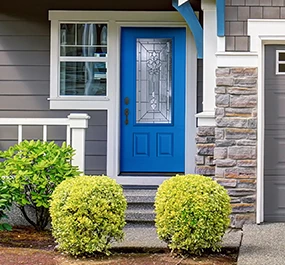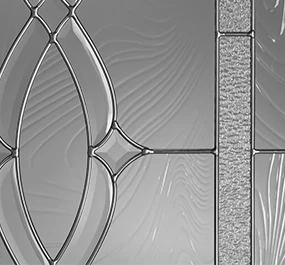There’s plenty to consider when choosing a fiberglass door for your home or business (be it the material, finish, color, or hardware), and one of the first things you’ll need to decide is if you want an inswing or outswing fiberglass exterior door, based on your space and depending on exterior conditions.
Both doors should be available options to you, but one may make more sense based on your space. Even if the choice seems evident, there may be unexpected factors to account for—like building swing codes, your location, and more.
Your building or locale may require a specific type of door
Residential and commercial buildings may require you to select a specific door based on your area’s structural guidelines. Always consult these guidelines before selecting your door; however, there are basic building swing codes that are fairly standard nationwide.
Areas with climates prone to snow typically require any exterior door to swing inward to avoid trapping the building inhabitants if large piles of snow are blocking the entryway. Outswing door units are required in High Velocity Hurricane Zones (HVHZ), because of the high risk of inswing doors being blown in during strong wind conditions. Meanwhile, doors in commercial buildings are generally required to swing outward per the International Building Code to ensure a safe and orderly evacuation.
Benefits of an outswing fiberglass exterior door
Outswing doors are categorized in building codes as “Right Hand Outswing,” or “Left Hand Outswing,” and have hinges on the right and left of the door respectively so that the door opens out of the room when pushed or pulled. As mentioned earlier, per the International Building Code, all commercial doors need to swing outward in case of evacuation. Many evacuation plans will even include mention of how the door should be held open for escape. Note that in commercial applications, Right Hand Outswing is also known as Left Hand Reverse, and Left Hand Outswing is known as Right Hand Reverse.
On a similar note, it could be argued that outswing fiberglass exterior doors are more secure than inswing since they’re harder to force open from the outside. For maximum security, your hinges should feature non-removable pins, being that they will be exposed on the exterior side of the door.
Outswing doors may also be better for areas with harsh climates like wetlands or windy areas—the threshold design and physics of an outswing fiberglass exterior door can better protect a home’s interior from damage or water leaks in these intense climates, particularly if there is the added protection of an overhang.
If tight on interior space, it might be best to install an outswing door to allow for more flexibility within the space. When choosing between an inswing or an outswing door, it is important to consider the amount of space the door may take up. Not only should you take into consideration the square footage of a room, but also the furniture that may be close to the door. For example, if a door is 36 inches wide, you will need at least 36 inches of clearance when opening it in (if inswing) or out (if outswing). You will also want to leave additional space for freedom of movement, which may make an outswing door more desirable.
Benefits of an inswing fiberglass exterior door
Inswing doors have multiple options and codes-when standing on the interior side of the door, there’s a Left Hand Inswing option, where the hinges are located on the left of the door or a Right Hand Inswing with the hinges on the right, although with either option the door opens into the room when pushed or pulled. For security purposes, inswing doors have hinges on the interior side of the house, so there’s less concern about them being pulled off for a forced entry. Again, however, it is typically easier to push in an inswing door than pry open an outswing door, so you may consider installing deadbolt locks for extra security.
Additionally, inswing doors typically require less maintenance. By nature, inswing doors have less exposure to the elements as compared to outswing doors—especially outswing doors without an overhang. Additional protection from moisture may be required when installing an outswing door, and there are more frequent weatherproofing needs. There is also a higher chance an outswing door could be ripped off its hinges due to intense wind if allowed to stand open.
Adding an overhang for additional protection
Lastly, an overhang can benefit both inswing and outswing fiberglass exterior doors. Overhangs provide cover and protection from direct sunlight, as well as from precipitation, keeping the unit from getting wet. However, the additional protection will add to the budget when building, so not every door will have the protection of an overhang. Take this into consideration when choosing your door type, as inswing doors make the feature somewhat less of a requirement.
Look to the experts for installation tips & tricks
If you have outstanding questions regarding the proper installation of inswing and outswing fiberglass exterior doors, or which type is best-suited to your exterior needs, consult your contractor. Leveraging their expert advice will be beneficial in finding the right door for your situation. For more information, utilize secondary resources like Plastpro’s Doorability function to design your dream entryway—and picture it in your space. Consult Plastpro’s guide to framing your exterior door for additional installation information.
Check out Plastpro’s Where to Buy page to find the closest distributor of inswing and outswing fiberglass exterior doors. For more information on our fiberglass door offerings, visit our website.



